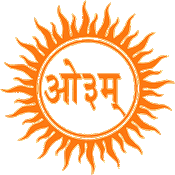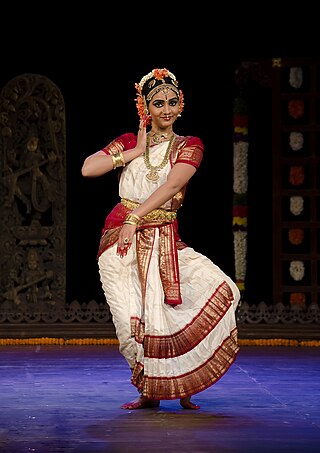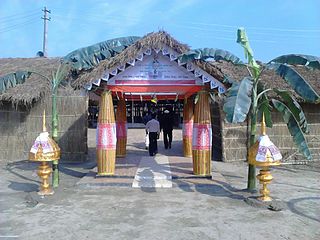
Arya Samaj is a monotheistic Indian Hindu reform movement that promotes values and practices based on the belief in the infallible authority of the Vedas. The samaj was founded by the sannyasi (ascetic) Dayanand Saraswati in the 1870s.

Kathakali is a traditional form of classical Indian dance, and one of the oldest theater forms still practiced. It is a "story game" genre of art, but one distinguished by the elaborately colourful make-up and costumes of the traditional male actor-dancers. It is native to the Malayalam-speaking southwestern region of Kerala and is almost entirely practiced by Malayali people.

Kuchipudi is one of the eight major Indian classical dances. It originates from a village named Kuchipudi in the Indian state of Andhra Pradesh. Kuchipudi is a dance-drama performance, with its roots in the ancient Hindu Sanskrit text of Natya Shastra. It developed as a religious art linked to traveling bards, temples and spiritual beliefs, like all major classical dances of India.
Sattriya, or Sattriya Nritya, is a major Indian classical dance. This dance was initially created as part of Bhaona which are performances of Ankiya Nat, one-act plays, originally created by Sankardev, the 15th-16th century polymath from Assam. These dances are part of the living traditions today of Sattras, which are communities of live-in devotees belonging to the Ekasarana dharma, the religion established by Sankardev.

The Kendriya Vidyalaya Sangathan is a system of central government schools in India that are instituted under the aegis of the Ministry of Education, Government of India. As of April 2023, it has a total of 1,253 schools in India, and three abroad in Kathmandu, Moscow and Tehran. It is one of the world's largest chains of schools and also the largest chain of schools in India. It is controlled by 25 Regional Offices and 05 ZIETs under KVS (HQ).

Indian classical dance, or Shastriya Nritya, is an umbrella term for different regionally-specific Indian classical dance traditions, rooted in predominantly Hindu musical theatre performance, the theory and practice of which can be traced to the Sanskrit text Natya Shastra. The number of Indian classical dance styles ranges from eight to twelve, or more, depending on the source and scholar; the main organisation for Indian arts preservation, the Sangeet Natak Academy, recognizes eight – Bharatanatyam, Kathak, Kuchipudi, Odissi, Kathakali, Sattriya, Manipuri and Mohiniyattam. Additionally, the Indian Ministry of Culture includes Chhau in its list, recognising nine total styles. Scholars such as Drid Williams add Chhau, Yakshagana and Bhagavata Mela to the list. Each dance tradition originates and comes from a different state and/or region of India; for example, Bharatanatyam is from Tamil Nadu in the south of India, Odissi is from the east coast state of Odisha, and Manipuri is from the northeastern state of Manipur. The music associated with these different dance performances consists many compositions in Hindi, Malayalam, Meitei (Manipuri), Sanskrit, Tamil, Odia, Telugu, and many other Indian-Subcontinent languages; they represent a unity of core ideas, and a diversity of styles, costumes and expression.
Barnala is a city in the state of Punjab of India. Barnala city serves as the headquarters of the Barnala district which was formed in 2006. Prior to formation of Barnala district, this city was located in Sangrur district. It is a centrally located district bordered by Ludhiana district on the north, Moga district on northwest, Bathinda district on west, Sangrur district on east and Mansa district on south side.
Tamasha is a traditional form of Marathi theatre, often with singing and dancing, widely performed by local or travelling theatre groups within the state of Maharashtra, India. It has also been the subject of several Marathi films. Some Hindi movies have also included Tamasha-themed songs, known as Lavanis, in the past.

Bhaona is a traditional form of entertainment, with religious messages, prevalent is Assam, India. It is a creation of Mahapurusha Srimanta Sankardeva, written in the early sixteenth century. He created the form to convey religious messages to villagers through entertainment. Later Srimanta Madhavdeva also wrote some plays. The plays of bhaona are popularly known as Ankiya Nats and their staging is known as bhaona. Bhaona is generally staged at xatras and namghars in Assam. There are some special characteristics of Bhaona like the plays, dialogues, costumes, ornaments, entry and foot-steps of the characters. These characteristics helps to differentiate Bhaona from other plays.

'Bayanacharya' Shri Ghanakanta Bora Muktiyar is one of the most eminent exponents and gurus of Sattriya dance, a major classical dance tradition of Assam, India. He is also a renowned instrumentalist, choreographer and author. He has won the prestigious Sangeet Natak Akademi Award in 2001.

Borgeets are a collection of lyrical songs that are set to specific ragas but not necessarily to any tala. These songs, composed by Srimanta Sankardeva and Madhavdeva in the 15th-16th centuries, are used to begin prayer services in monasteries, e.g. Satra and Namghar associated with the Ekasarana Dharma; and they also belong to the repertoire of Music of Meghalaya outside the religious context. They are a lyrical strain that express the religious sentiments of the poets reacting to different situations, and differ from other lyrics associated with the Ekasarana Dharma. Similar songs composed by others are not generally considered borgeets.
Ankia Naats are a class of one act plays performed in Assam, India. The invention of the Ankia Naat is usually attributed to the medieval saint and social reformer Srimanta Sankardeva. These plays were written in an artificial old medieval period poetic Assamese mixed language called Brajavali and are primarily centered on Krishna. A particular presentation of an Ankia Naat is called a Bhaona. The plays usually combine live instruments and singers, dance and elaborate costumes in production.

Barechahariya Bhaona is a 200-year-old drama festival held every 5–6 years at Jamugurihat, a small town in Sonitpur District, Assam. The festival was first held in 1797-98. Led by Gayan Bora and sounds of Doba, Kanh, Bhortal and Khol resonates amidst the audience to signal the start of the Barechaharia Bhaowna. This tradition that dates back two centuries, livens up the small town of Jamugurihat.

Vrindavani Vastra is a drape woven by Assamese weavers led by Mathuradas Burha Aata during 16th century under the guidance of Srimanta Sankardeva, a Vaishnavite saint and scholar who lived in present-day Assam. The lead weaver Mathuradas Burha Aata a disciple of Sri Sri Madhabdev, who was the first Satradhikar of the Barpeta Satra. Mathuradas Burha Aata along with his 12 assistant weavers wove the Brindavani Bastra. The large drape illustrates the childhood activities of Lord Krishna in Vrindavan. Parts of the original Vrindavani vastra are presently owned by the Victoria and Albert Museum in London and Musee Guimet in Paris. The piece of cloth demonstrates the skillful weaving methods developed during medieval times and such complexity is rarely seen in present-day Assam.
Jorhat is one of the important cities and a growing urban centre in the state of Assam in India.
Jamugurihat is a town and a town area committee in Sonitpur district, in the Indian state of Assam. This is a newly planned city area by the Urban Development Authority of Assam. The town is located north of the Brahmaputra River. It is the location of the 200-year-old Baresahariya Bhaona festival.

Tulsidas Borkar was an Indian composer and harmonium player. The Government of India awarded him the civilian honour of the Padma Shri in 2016.

Madhupur Satra is a religious institutional center associated with the Ekasarana tradition of Vaishnavism, situated in Cooch Behar, the Indian state of West Bengal. It was established by Assamese Vaishnavite monasteries for religious practices in the mid 16th-century during Koch kingdom (1515–1949). The great Bhakti Saint Mahapurusha Srimanta Sankardeva (1449–1568) and his disciple Mahapurusha Madhavadeva died here. Madhupur satra is also called as Dahmukutor than; 'dahmukut' means 'bhiti' or living houses of ten disciples (bhaktas) of Srimanta Sankardeva. The name satra originates in the Bhagavata Purana in Sanskrit (sattra), and is used in the sense of an assembly of devotees.
Ardhendu Sekhar Mustafi was a Bengali actor, playwright and theater personality.

Indira P. P. Bora is a Satriya dancer from Assam, India. Trained in Bharatnatyam for 13 years under Guru Rukmini Devi Arundale and in Kuchipudi under the guidance of Guru Vempati Chinna Satyam. Bora has promoted and performed Satriya in New Zealand, the United States, and Vietnam.












